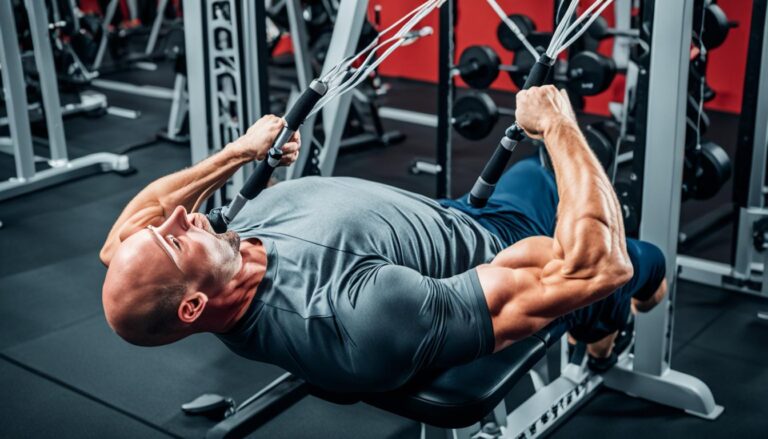Building muscle quickly can seem like a daunting task, but with the right strategies, you can see significant gains in a relatively short time. In this comprehensive guide, I will reveal the secrets to rapid muscle growth that will help you fast-track hypertrophy efficiently.
This article is dedicated to providing you with a multi-faceted approach that includes essential elements such as diet, exercise, supplementation, and recovery. Understanding the dedication required for muscle hypertrophy is crucial if you aim to build muscle fast.
By focusing on increasing training volume, emphasizing eccentric muscle actions, and optimizing your nutrition with adequate protein intake and calorie surplus, you can maximize your muscle growth. I will also touch on the importance of adequate sleep, supplementation with creatine, and the addition of HMB to prevent muscle breakdown and promote growth.
To further enhance your knowledge, check out this detailed article on unbeatable nutrition strategies for muscle. By following these tips and maintaining consistent dedication, you will be well on your way to achieving your muscle-building goals rapidly.
Key Takeaways
- Increasing training volume is essential for muscle growth.
- Focus on eccentric muscle actions to optimize hypertrophy.
- Adequate protein intake and maintaining a calorie surplus are vital for building muscle fast.
- Incorporate creatine and HMB supplementation to support muscle growth.
- Ensure you are getting enough sleep for optimal recovery and growth.
Understanding Muscle Hypertrophy
The quest for larger and stronger muscles leads us to the fascinating concept of muscle hypertrophy. It is the process through which muscles increase in size, driven by various stimuli such as resistance training and proper nutrition. Understanding the science of muscle growth can help optimize muscle-building efforts and tailor personalized fitness programs to achieve faster and more effective results.
The Science Behind Muscle Growth
The science of muscle growth revolves around several key components that work together to increase muscle mass. When you engage in resistance training, microtears occur in the muscle fibers. This signals the body to repair the damaged fibers, making them bigger and stronger in the process. The involvement of satellite cells plays a crucial role in muscle repair and growth. These cells activate and fuse to the damaged muscle fibers, facilitating repair and leading to muscle hypertrophy.
Types of Hypertrophy: Myofibrillar vs. Sarcoplasmic
Muscle hypertrophy can be broadly divided into two types: myofibrillar and sarcoplasmic hypertrophy. Each type contributes differently to the muscle’s appearance and function.
- Myofibrillar Hypertrophy: This type of hypertrophy involves an increase in the number and size of myofibrils, the contractile components of muscle tissue. It primarily enhances muscle strength and density, making muscles larger and more powerful.
- Sarcoplasmic Hypertrophy: This type focuses on increasing the volume of the sarcoplasm, the fluid and energy-storing components within the muscle cells. While it results in a more voluminous appearance, it does not significantly improve muscle strength. It is commonly seen in bodybuilders aiming for size over strength.
Both forms of hypertrophy are essential for a well-rounded muscle development program. Incorporating exercises and training techniques that target both myofibrillar and sarcoplasmic hypertrophy can lead to balanced muscle growth, improved strength, and an aesthetically pleasing physique.
To effectively incorporate these concepts into a workout regimen, it’s beneficial to seek personalized guidance and support. Abdullaah Yaseen’s coaching program offers tailored advice to help individuals navigate the complexities of muscle hypertrophy and achieve their fitness goals. Visit his website to learn more about customized weight loss and muscle-building strategies.
What Helps Build Muscle Fast?
Achieving rapid muscle growth requires a multifaceted approach that includes optimal workout routines, tailored nutritional strategies, and crucial lifestyle changes. By combining the right elements, anyone can build muscle fast and efficiently.
One of the most effective muscle growth strategies involves a well-structured strength training regimen. Focusing on compound lifts such as squats, deadlifts, and bench presses engages multiple muscle groups, leading to faster hypertrophy. Incorporating progressive overload ensures continuous muscle adaptation and growth.
Nutritional strategies are equally important to build muscle fast. A balanced diet rich in protein, carbohydrates, and healthy fats fuels muscle recovery and growth. Consuming protein-rich foods like chicken, fish, and legumes helps to repair and build muscle tissues post-exercise. Additionally, adequate hydration plays a crucial role in maintaining muscle function and promoting recovery.
Complementing your workout and diet with lifestyle changes can further accelerate muscle growth. Prioritizing sleep and managing stress effectively can optimize the body’s natural growth processes. Educating yourself through valuable resources like Abdullaah Yaseen’s blog offers insightful tips and advanced strategies for enhancing your muscle-building journey.
Optimal Diet for Muscle Growth
Achieving optimal muscle growth isn’t just about rigorous training; it also demands a well-balanced diet. Understanding the nutritional components that contribute to muscle hypertrophy can significantly enhance your results, whether you workout at home or at the gym.
Importance of a High Protein Diet
A high protein diet is critical for muscle growth as it provides the essential amino acids necessary for repairing and building muscle tissues. Consuming adequate protein from sources like lean meats, eggs, and plant-based proteins ensures that your body has the building blocks it needs for effective muscle recovery and growth. Incorporating protein-rich foods into every meal can help support sustained muscle hypertrophy.
Role of Carbohydrates and Fats
Carbohydrates and muscle building go hand-in-hand as carbs are the primary energy source for high-intensity workouts. Foods rich in complex carbohydrates such as whole grains, fruits, and vegetables provide the sustained energy required for vigorous training sessions. Additionally, the fats role in hypertrophy cannot be underestimated. Healthy fats like those found in avocados, nuts, and olive oil help in synthesizing hormones that are vital for muscle growth and overall health.
| Macronutrient | Benefits | Sources |
|---|---|---|
| Protein | Muscle repair and growth | Lean meats, eggs, plant-based proteins |
| Carbohydrates | Energy for workouts | Whole grains, fruits, vegetables |
| Fats | Hormone synthesis, overall health | Avocados, nuts, olive oil |
Hydration and Muscle Growth
Often overlooked, hydration for muscle growth is incredibly important. Water is necessary for various physiological processes, including nutrient transport and muscle contractions. Staying hydrated enhances your workout performance and helps prevent muscle cramps and fatigue. Ensure you drink plenty of water before, during, and after your exercise sessions to maintain optimal hydration levels and support your muscle-building efforts.
Whether you’re working out at home or hitting the gym, balancing your diet with the right proportions of protein, carbohydrates, and fats is crucial. For more insights on effective training methods and the convenience of home workouts, check out this comprehensive guide.
Effective Strength Training Exercises
Strength training exercises are crucial for anyone serious about building muscle mass and improving overall fitness. Incorporating these exercises into your routine not only enhances muscle hypertrophy but also offers a host of other benefits that promote long-term health and wellness.
Benefits of Strength Training
There are numerous strength training benefits that can’t be overlooked. Regular strength training exercises can help improve muscle tone, increase bone density, and boost metabolic rates. Additionally, it aids in maintaining a healthy weight, enhancing posture, and reducing the risk of injury. These muscle building workouts are essential for anyone looking to enhance their physical capabilities and overall health.
Top Strength Training Exercises
When it comes to selecting the most effective strength training exercises, it’s important to focus on movements that target multiple muscle groups. Here is a list of some of the best exercises that should be an integral part of any muscle building workouts routine:
- Squats: This fundamental exercise targets the quadriceps, hamstrings, and glutes, providing a comprehensive lower body workout.
- Deadlifts: Perfect for engaging the entire posterior chain, including the back, glutes, and hamstrings.
- Bench Press: A staple for developing chest, shoulder, and triceps strength.
- Pull-Ups: Excellent for building up back, shoulder, and arm muscles, while also improving grip strength.
- Overhead Press: Targets the shoulders, triceps, and upper chest, helping to build impressive upper body strength.
- Rows: Important for enhancing back strength and posture, focusing on the middle and upper back muscles.
Incorporating these strength training exercises into your workout regimen will maximize your strength training benefits, helping you achieve optimal results in muscle building workouts. Always remember to maintain proper form and progressively increase weights to continue challenging your muscles.
The Power of Compound Lifts
Compound lifts are a vital component of any effective strength training routine, enabling individuals to build muscle fast by engaging multiple muscle groups simultaneously. The magic of these exercises lies in their efficiency, making them a cornerstone for anyone seeking substantial strength gains and considerable muscle hypertrophy.
Exercises like squats, deadlifts, and bench presses are quintessential compound lifts. These movements not only target primary muscle groups but also engage numerous stabilizing muscles, thereby enhancing overall muscle mass and facilitating quicker strength improvements. For example, a squat primarily targets the quadriceps, hamstrings, and glutes while also engaging the core and lower back for stabilization.
“Compound exercises should be the foundation of your strength training program if you aim to build muscle fast and increase overall functional strength,” says renowned fitness expert Brad Schoenfeld.
One of the significant advantages of compound lifts over isolation exercises is the ability to lift heavier weights. This leads to a greater stimulus for muscle growth and superior strength training adaptations. Moreover, compound movements mimic natural body movements, enhancing not only aesthetic gains but also functional strength essential for everyday activities.
| Exercise | Primary Muscles Targeted | Secondary Muscles Engaged |
|---|---|---|
| Squat | Quadriceps, Hamstrings, Glutes | Core, Lower Back |
| Deadlift | Hamstrings, Glutes, Lower Back | Core, Trapezius |
| Bench Press | Pectorals, Triceps | Deltoids, Core |
To maximize the benefits of compound lifts, it’s crucial to follow proper form and technique. Incorrect execution can lead to injuries and negate the muscle-building advantages they offer. Consider including these exercises in your strength training regimen to build muscle fast and achieve a balanced, powerful physique.
Integrating compound lifts into your routine will not only expedite muscle growth but also build a solid foundation for future strength training endeavors. By focusing on movements that encourage multiple muscle groups to work in unison, you are setting yourself up for sustained progress and holistic fitness improvements.
Progressive Overload: The Key to Continuous Gains
Progressive overload is a fundamental principle in strength training, focusing on the need to continually increase the demands placed on the muscles to achieve continuous muscle gains. By gradually intensifying workout adaptations, athletes ensure their muscles grow stronger over time.
What is Progressive Overload?
At its core, progressive overload is the practice of steadily increasing the stress placed on the muscles during training. This increase can be through heavier weights, more repetitions, or greater exercise intensity. The objective is to challenge the muscles to adapt continually, leading to increased strength and muscle mass.
Techniques to Implement Progressive Overload
There are several techniques to effectively integrate progressive overload into your training regime:
- Increase Weights: Gradually adding more weight to your exercises forces your muscles to handle greater loads, promoting muscle growth.
- Increase Reps: Performing more repetitions with the same weight can also enhance workout adaptations by increasing muscle endurance and strength.
- Increase Intensity: Amplifying the intensity of your workouts—such as reducing rest time between sets—can significantly boost muscle adaptation and growth.
- Variation in Exercises: Incorporating different exercises targeting the same muscle groups prevents plateaus and encourages continuous muscle gains.
Implementing these techniques ensures your muscles are consistently engaged and challenged, fostering progressive growth and strength improvements.
Incorporating Muscle Growth Supplements
For many fitness enthusiasts, muscle growth supplements are essential tools to boost muscle mass and performance. These supplements can significantly enhance training results by providing critical nutrients and compounds that promote muscle hypertrophy. Let’s delve into some popular options and essential tips for effective supplement selection.
Popular Supplements for Muscle Growth
Understanding which supplements are effective for muscle growth is crucial. Here are some of the best muscle building supplements that have shown impressive results:
- Whey Protein: This fast-digesting protein supports muscle repair and growth post-workout.
- Creatine Monohydrate: Known for enhancing strength and performance, creatine helps in muscle mass gain.
- Branched-Chain Amino Acids (BCAAs): Essential for muscle protein synthesis, BCAAs reduce muscle fatigue and soreness.
- Beta-Alanine: This amino acid improves exercise performance by buffering muscle acid levels.
- Glutamine: Glutamine aids in muscle recovery and immune support post intense training sessions.
Choosing the Right Supplement for You
With numerous options available, selecting the right muscle growth supplements for your needs can be challenging. Consider these factors to make an informed supplement selection:
“The best muscle building supplements are those that align with your fitness goals, dietary needs, and training regimen.”
- Identify Goals: Determine whether your focus is on muscle mass, recovery, or performance.
- Check Ingredients: Look for high-quality ingredients without unnecessary additives.
- Review Research: Opt for scientifically-backed supplements with proven efficacy.
- Consider Diet: Ensure the supplement complements your nutritional intake.
- Consult Professionals: Seek advice from fitness trainers or nutritionists for personalized recommendations.
Here’s a comparative table of some of the best muscle building supplements:
| Supplement | Primary Benefit | Recommended Use |
|---|---|---|
| Whey Protein | Muscle Repair & Growth | Post-Workout |
| Creatine Monohydrate | Strength & Performance | Pre-Workout |
| BCAAs | Reduce Fatigue & Soreness | During Workout |
| Beta-Alanine | Improve Performance | Pre-Workout |
| Glutamine | Muscle Recovery | Post-Workout |
By integrating the right muscle growth supplements into your routine, you can optimize your efforts and achieve your fitness goals more efficiently. Always remember the importance of proper supplement selection to enhance your muscle-building journey.
The Anabolic Window: Maximizing Post-Workout Nutrition
Understanding the anabolic window is fundamental to optimizing muscle recovery and growth. This critical period occurs immediately after a workout when the body’s ability to absorb nutrients is significantly enhanced. During this time, proper post-workout nutrition can accelerate muscle protein synthesis, aiding in quicker recovery and promoting muscle growth.
One of the main strategies to take advantage of the anabolic window is to consume a balanced meal rich in protein and carbohydrates within 30 to 45 minutes post-exercise. This combination helps replenish glycogen stores and repair muscle tissues effectively.

Here’s a detailed look at the components of optimal post-workout nutrition:
| Nutrient | Function | Sources |
|---|---|---|
| Protein | Repairs and builds muscle tissues | Poultry, fish, dairy, plant-based proteins |
| Carbohydrates | Replenishes glycogen stores | Whole grains, fruits, vegetables |
| Fats | Supports hormone production and cell structure | Avocado, nuts, seeds |
By strategically planning your post-workout nutrition, you can ensure that the most is made out of the anabolic window. This approach not only enhances muscle recovery but also sets the stage for long-term muscle growth and performance improvement. For individuals serious about building lean muscle, mastering this period with the right nutritional choices is non-negotiable.
The Importance of Adequate Recovery
As you work towards building muscle, it’s essential to recognize the significant role adequate recovery plays in your overall progress. Your muscles require time to repair and grow stronger after intense workouts, making recovery just as important as your exercise regimen. Failing to prioritize recovery can lead to overtraining, which hampers muscle growth and increases the risk of injury.
Sleep and Muscle Recovery
Quality sleep is paramount for muscle recovery. During deep sleep stages, your body releases growth hormone, which stimulates muscle repair and development. Aim for 7-9 hours of sleep each night to optimize muscle recovery and performance. Poor sleep can undermine your efforts, reducing muscle building efficiency and slowing down overall progress.
Active Recovery Methods
Incorporating active recovery techniques into your routine can further enhance muscle repair. Activities such as light cardio, stretching, and foam rolling help increase blood flow, delivering essential nutrients to damaged muscles. Supplements like Coenzyme Q10, glutamine, and krill oil can also aid in reducing muscle damage and promoting protein metabolism. To explore more about these supplements, check this comprehensive study on recovery supplements.
By integrating both sleep and active recovery methods, you’ll ensure that your muscles have adequate recovery time to rebuild stronger and more resilient, ultimately enhancing your overall performance and gains.
FAQ
What helps build muscle fast?
Building muscle quickly involves a combination of proper nutrition, strategic workout routines, adequate recovery, and sometimes the use of muscle growth supplements. Elements like a high protein diet, compound lifts, and progressive overload are crucial to fast muscle gains.
What is muscle hypertrophy?
Muscle hypertrophy is the process of muscle fibers enlarging due to strength training exercises. It’s essential for increasing muscle size and is driven by the principles of progressive overload and adequate nutrition.
What are the differences between myofibrillar and sarcoplasmic hypertrophy?
Myofibrillar hypertrophy focuses on increasing muscle strength by enlarging the muscle fibers, while sarcoplasmic hypertrophy enhances muscle size through an increase in muscle glycogen storage. Both types are beneficial depending on your muscle-building goals.
Why is a high protein diet important for muscle growth?
Protein provides the essential amino acids necessary for muscle repair and growth. Consuming a high protein diet helps in recovering muscle tissues post-exercise, allowing for continuous muscle hypertrophy.
How do carbohydrates and fats contribute to muscle building?
Carbohydrates provide the energy required for intense workouts, whereas healthy fats support hormone production, including testosterone, which is crucial for muscle growth. Both macronutrients play supportive roles in a high-protein diet.
Why is hydration important for muscle growth?
Staying hydrated is vital as it helps maintain muscle function and performance. Proper hydration aids in nutrient transport and recovery, contributing to overall muscle hypertrophy and strength.
What are some top strength training exercises for muscle building?
Effective strength training exercises for muscle building include compound lifts like squats, deadlifts, bench presses, and overhead presses. These exercises target multiple muscle groups and are essential for rapid muscle growth.
How does progressive overload work?
Progressive overload involves gradually increasing the amount of stress placed on the muscles during workouts. This can be done by lifting heavier weights, increasing reps, or enhancing workout intensity. It’s key to continuous muscle adaptation and growth.
What are some popular muscle growth supplements?
Common muscle growth supplements include whey protein, branched-chain amino acids (BCAAs), creatine, and beta-alanine. These supplements can help support muscle repair, energy levels, and overall performance.
What is the anabolic window?
The anabolic window is the period post-workout (usually within 30 minutes to an hour) when the body is primed to absorb nutrients efficiently. Consuming a balanced meal with protein and carbohydrates during this window can maximize muscle recovery and growth.
How important is recovery for muscle growth?
Adequate recovery is crucial as it allows muscles time to heal and grow stronger. This includes getting sufficient sleep, which supports muscle repair, and engaging in active recovery methods like stretching and low-intensity activities to enhance circulation and reduce muscle soreness.






